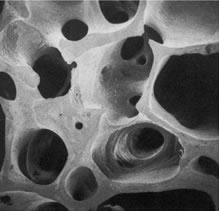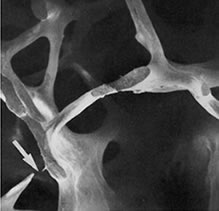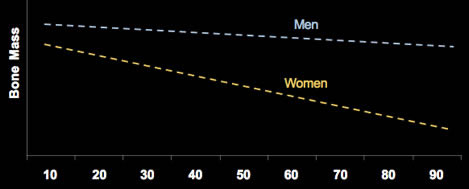What is Osteoporosis?
Osteoporosis is a skeletal disease characterized by low bone mass that results in a reduction in the strength of the skeleton.
 Normal Bone Normal Bone |
 Osteoporotic Bone Osteoporotic Bone |
The Scope of the Problem
- Osteoporosis affects as many as 44 million Americans
- 80% of those affected are women
- One in two women and one in four men over age 50 will have an osteoporosis-related fracture in her/his remaining lifetime
- While osteoporosis is often thought of as an older person’s disease, it can strike at any age
Consequences of Osteoporosis
- Increased risk of fracture of the hip, spine, and wrist
- Morbidity and mortality from fracture
– Over 300,000 hip fractures/year
– A 50-year-old white woman has a 15% lifetime probability of suffering a hip fracture - Healthcare costs
– 2002: $18 billion
Fractures of the Hip and Spine
Osteoporosis and Osteoarthritis
| Osteoporosis | Osteoarthritis | |
| What is affected? | Bones, which become more fragile and more likely to break | Joints, especially weight-bearing joints (knees, feet, hips, and back) |
| Whom does it affect? | 4 of 5 people suffering from osteoporosis are women occurs most commonly after the age of 45 | Men and women equally; usually occurs after age 45 |
| Why does it happen? | Loss of bone mass, related to certain risk factors | Join structure weaken and wear down |
Who is at Risk? Risk Factors for Osteoporosis
- Age
- Gender
- Race
- Bone structure and body weight
- Menopause and menstrual history
- Lifestyle
- Medications and disease
- Family history
Osteoporosis and Menopause
Bone loss due to decline in estrogen is the leading cause of osteoporosis in women.

Diagnosing Osteoporosis
If osteoporosis is painless, how do I know if my bones are healthy?
Keeping Bones Strong -The Keys to Prevention
- The importance of calcium and vitamin D as part of a healthy diet
- The value of weight-bearing exercise
- Making lifestyle changes
- Medications that prevent bone loss
The Importance of Calcium
Optimal Daily Calcium Intake*
| Age Group (in years) | Calcium (in milligrams) |
| 1 – 5 6 – 10 11 – 24 |
800 800 – 1200 1200 – 1500 |
| Men 25 – 50 Over 65 |
1000 1500 |
| Women 25 – 50 50 – 65 taking estrogen 50 – 65 not taking estrogen Over 65 Pregnant or nursing |
1000 1000 1500 1500 1200 – 1500 |
Reference:
* Optimal Daily Calcium Intake. NIH Consensus Statement 1994
Vitamin D and Calcium Absorption
 Your body needs vitamin D to absorb calcium.
Your body needs vitamin D to absorb calcium.
—> Vitamin D —> Helps the body absorb calcium
The Value of Exercise
- Weight-bearing: Jogging, walking, stair climbing, dancing and soccer are examples of weight-bearing exercise with different degrees of impact
- Resistance: These activities include weight lifting, such as using free weights and weight machines found at gyms and health clubs
Making Lifestyle Changes
- No Smoking
- No Drinking
Medications That Help Prevent Osteoporosis
- Estrogen/hormone therapy
- Bisphosphonates
- Calcitonin
- Parathyroid hormone
- Selective estrogen receptor modulators (SERMs)
Estrogen Can Dramatically Reduce Fracture Risk

Vertebral fracture frequency as a function of age among female patients in the Kaiser-Permanente population in San Francisco
Benefits and Risks of Estrogen
Benefits of Estrogen
- Controls symptoms of menopause (vasomotor symptoms and urogenital problems)
- Prevents osteoporosis
- Decreases risk of cardiovascular disease
Risks of Estrogen
- Increases risk of endometrial cancer if used without a progestational agent
- Possible increased risk of breast cancer
Breast Cancer Risk and Postmenopausal Hormone Therapy
What Are the Facts?
- Evidence for an association between postmenopausal hormone therapy and breast cancer risk is inconclusive
- Virtually all studies show no increased risk with short-term, current use (i.e., < 5 years) or past use
- Some studies show a slightly increased risk with long-term, current use (i.e., > 5 years)
Medications That Help Prevent Osteoporosis
| Bisphosphonates | |
| Drug Type | Bisphosphonate |
| Brand Name | Fosamax® |
| How It Works | Inhibits the cells in the skeleton that break down bone; decreases bone loss and allows bone mass to increase |
| Side Effects | Gastrointestinal problems: musculoskeletal pain and/or headache |
| SERMs | |
| Drug Type | Selective estrogen receptor modulator (SERM) |
| Brand Name | Evista® |
| How It Works | Binds to the same receptor in bone as estrogen binds, and so mimics estrogen’s beneficial effects on bone density |
| Side Effects | Hot flashes, leg cramps |
| Calcitonin | |
| Drug Type | Calcitonin |
| Brand Name | Miacalcin® |
| How It Works | Prescription nasal spray for the treatment of postmenopausal osteoporosis in women more than 5 years after menopause for which estrogens are not an option |
| Side Effects | Nasal symptoms (runny nose, crusting, nosebleed, etc.), back and/or joint pain, and headache |
| Parathyroid Hormone | |
| Drug Type | Teriparatide (PTH 1-34) |
| Brand Name | Fortéo® |
| How It Works | Teriparatide is a man-made form of the active part of a natural hormone that is injected by the patient. It works by increasing bone mass and strength which decreases the chance of getting a fracture |
| Side Effects | Dizziness, leg cramps, angina, nausea, vomiting, muscle weakness, constipation, sluggishness, angina |
If You Have Osteoporosis
- Exercise
- Calcium
- Medications
– Estrogen
– Bisphosphonates
– SERMs
– Calcitonin - Minimize the chances of breaking a bone
Osteoporosis Prevention Summary
- Osteoporosis is preventable and treatable
- Hormone replacement/estrogen replacement is first-line therapy for osteoporosis
- Adequate calcium intake, exercise, and lifestyle changes also play an important role in helping to prevent osteoporosis
- For those who cannot or will not take HRT, but have or are at risk for osteoporosis, other agents are now available